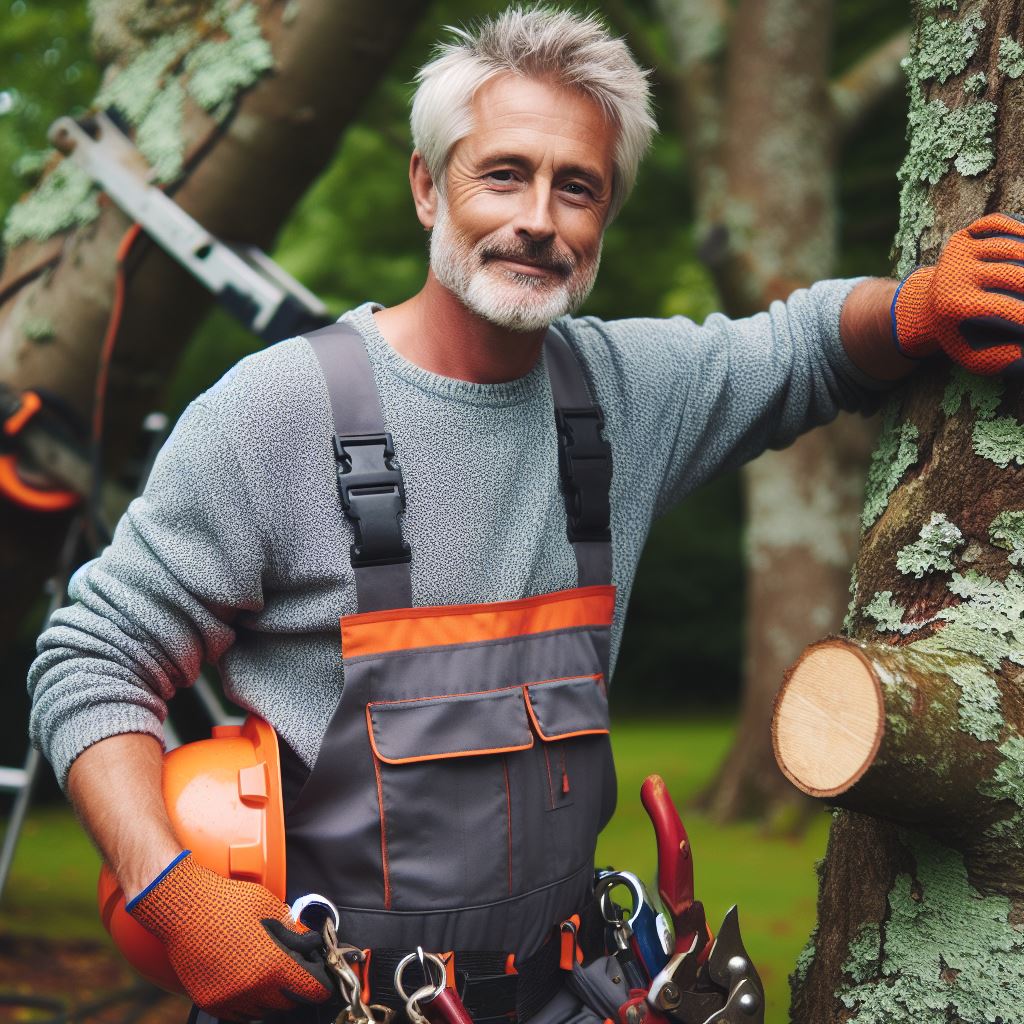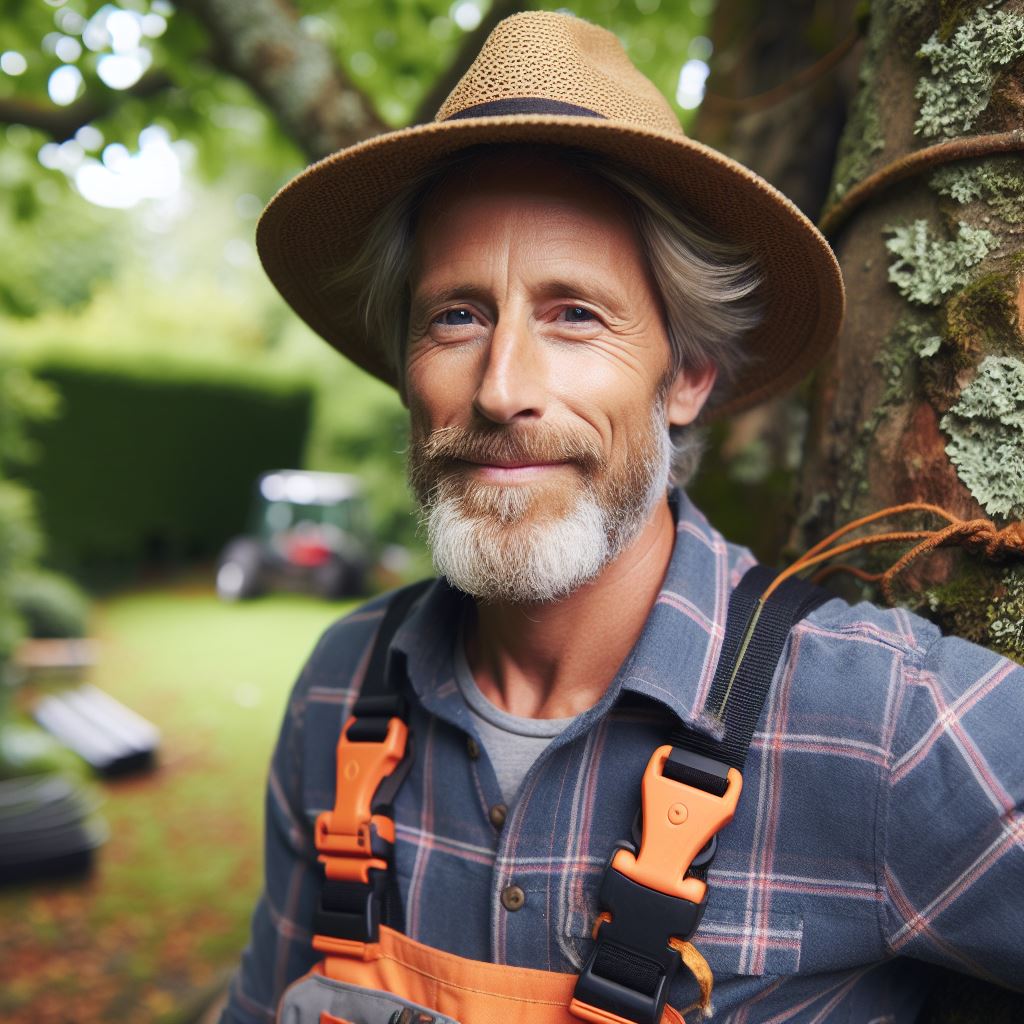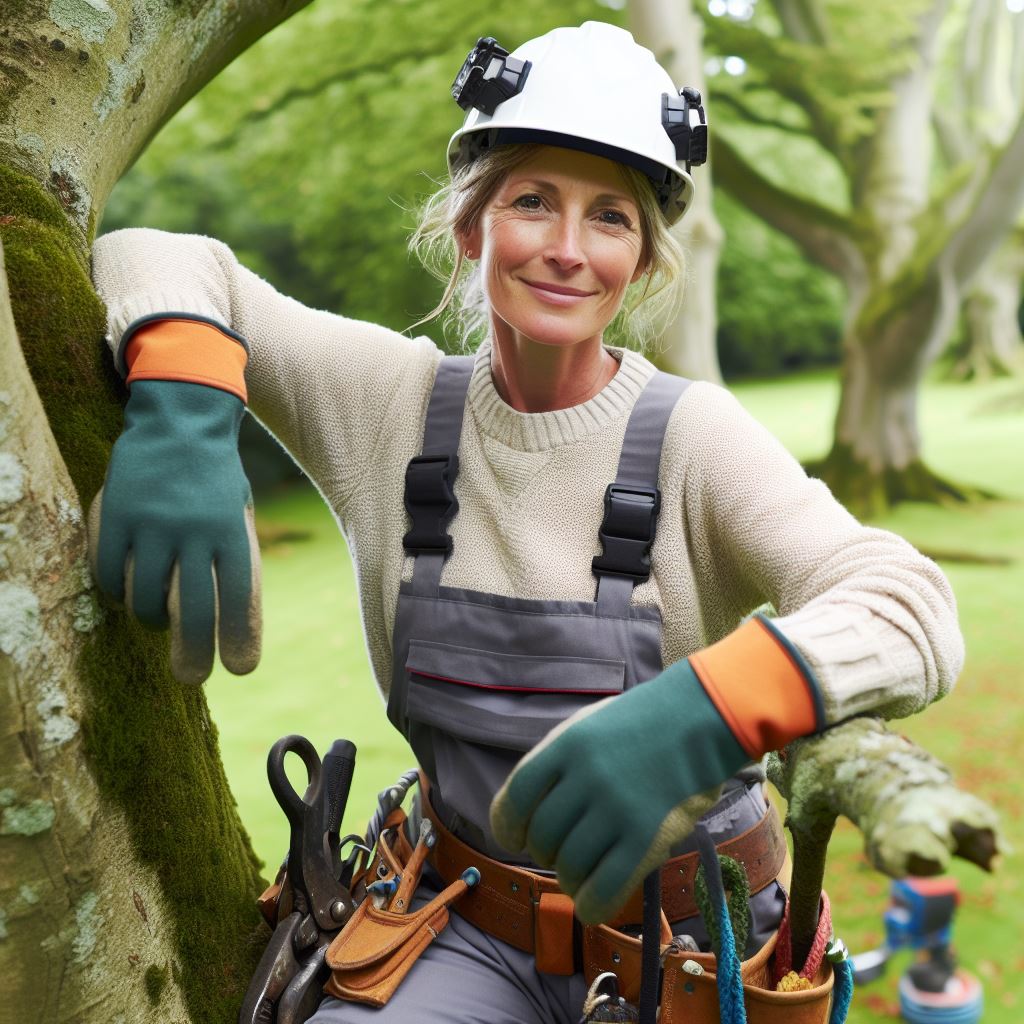Introduction
Arborist safety techniques in the UK are crucial for the well-being of tree care professionals.
The importance of these safety measures cannot be overstated as they play a vital role in preventing accidents and injuries.
Arborists perform tasks at great heights and often deal with heavy machinery and sharp tools, making safety precautions essential.
These measures ensure that arborists can carry out their work effectively and without unnecessary risks.
By understanding and implementing these crucial safety measures, arborists can navigate the challenges of their work with confidence and ensure their own safety and the well-being of those around them.
Join us as we delve into the world of arborist safety in the UK.
By understanding the risks and embracing essential safety measures, we can foster a culture of safety in the industry, protecting arborists and ensuring they continue to thrive in their vital role as guardians of our urban forests.
In the section, we will explore different safety techniques that are followed in the UK to ensure the well-being of arborists.
Overview of the Arborist Profession in the UK
what arborists do and their role in the UK
Arborists play a crucial role in the UK, maintaining and managing trees in various settings.
- Arborists are professionals dedicated to the care and management of trees, ensuring their health and sustainability.
- They possess a wide range of skills, including tree pruning, planting, disease diagnosis, and tree removal when necessary.
- Arborists in the UK work in various environments such as urban areas, parks, gardens, and forests.
- Their role goes beyond just looking after trees; they also provide advice on tree-related issues and contribute to biodiversity conservation.
- Arborists are known for their expertise in assessing tree health, identifying potential hazards, and implementing appropriate corrective measures.
- They often collaborate with landscape architects and other professionals in the planning and development of green spaces.
Importance of Safety in Arboriculture
Safety is an integral aspect of arboriculture, considering the potential risks involved in working with trees.
- Arborists prioritize safety to protect themselves, their team members, and the general public while carrying out their duties.
- The use of Personal Protective Equipment (PPE) is crucial, including helmets, goggles, gloves, and chainsaw-resistant clothing.
- Regular training and refresher courses enable arborists to stay updated with the latest safety techniques and equipment.
- Proper risk assessment is conducted before any task, ensuring potential hazards are identified and appropriate mitigation measures are implemented.
- Arborists are trained to recognize and address potential dangers such as unstable trees, overhead hazards, and electrical lines.
- Working at height is a significant part of arboriculture, necessitating the use of safety harnesses and ropes to prevent falls.
- Arborists are trained in the correct use of tools and equipment, minimizing the risk of accidents or injuries.
- Communication and teamwork are vital for safe arboriculture, ensuring everyone involved is aware of their roles and responsibilities.
- Regular inspections of equipment and maintenance of tools help prevent malfunctions and potential accidents.
- Arborists also advocate for public safety by educating communities about the importance of tree care and potential hazards.
Basically, arborists in the UK play a crucial role in maintaining tree health and safety. Their expertise ensures the well-being of trees, the environment, and the people who interact with them.
Safety remains at the forefront of their profession, and through ongoing training and dedication, arborists continue to provide valuable services in a safe and responsible manner.
Legal and Regulatory Requirements
The legal and regulatory requirements
Arborists in the UK are subject to legal and regulatory requirements to ensure their safety and compliance with laws and regulations. These requirements aim to protect both the arborists themselves and the general public.
The relevant laws and regulations
Arborists in the UK must adhere to legal requirements for safety:
- The Health and Safety at Work Act 1974 mandates a safe working environment and employer responsibilities.
- Provision and Use of Work Equipment Regulations 1998 ensure arborists use safe, suitable tools, regularly inspected.
- Personal Protective Equipment at Work Regulations 1992 require arborists to wear appropriate gear.
- Control of Substances Hazardous to Health Regulations 2002 govern handling chemicals for safety.
- Work at Height Regulations 2005 focus on safety while working above ground, including risk assessment.
- Manual Handling Operations Regulations 1992 provide guidelines for safe lifting and prevention of injuries.
- Control of Noise at Work Regulations 2005 set limits for noise exposure and require protective measures.
- Road Traffic Act 1988 regulates vehicle use, licensing, insurance, and traffic laws compliance.
- Electricity at Work Regulations 1989 ensure safety near power lines with appropriate training and equipment.
- Wildlife and Countryside Act 1981 protects trees and wildlife, regulating removal and relocation of habitats.
Arborists must stay updated on legal changes for compliance, ensuring a safe working environment for all.
Personalized UK Career Consulting
Receive tailored career guidance designed just for you. Get actionable steps and expert support to boost your career in 1-3 days. Take control of your career now.
Get StartedRead: Forestry Careers: Paths and Progressions
Personal Protective Equipment (PPE)
Arborists play a crucial role in maintaining and caring for trees, but their jobs can be dangerous. That is why it is essential for arborists to wear proper Personal Protective Equipment (PPE).
Wearing appropriate PPE not only protects the arborist from potential hazards, but it also ensures their safety and allows them to work efficiently.
The importance of wearing proper PPE for arborists
The importance of wearing proper PPE cannot be overstated. Arborists often work at significant heights, using chainsaws, and handling heavy equipment.
Without the right protection, they are at risk of injuries such as cuts, falls, and falling objects. PPE acts as a barrier between arborists and potential hazards, reducing the chances of accidents and injuries.
Different types of PPE used in arboriculture
Arborists use diverse PPE for safety:
- Head Protection: Wear helmets with chin straps to guard against falling debris and branches.
- Eye and Face Protection: Use impact-resistant goggles or face shields for shielding against wood chips.
- Hearing Protection: Mitigate noise with earplugs or earmuffs during chainsaw operation.
- Hand Protection: Use cut-resistant gloves for handling sharp tools, enhancing grip and reducing fatigue.
- Leg Protection: Employ chainsaw-resistant leg pads or trousers made from specialized materials.
- Foot Protection: Choose sturdy steel-toed boots with good traction and ankle support to prevent injuries.
- High-Visibility Clothing: Wear in critical visibility situations to reduce accident risks and stay visible.
Ensure proper PPE use and maintenance:
- Regularly inspect gear for damage or wear.
- Immediately replace defective PPE.
Receive comprehensive training on PPE usage and care.
Essentially, wearing suitable PPE is vital:
- Safeguards against hazards.
- Reduces accident and injury risks.
- Facilitates efficient work in arboriculture.
Prioritize personal protection, especially in high-risk professions like arboriculture.
Read: UK Farming Subsidies: Understanding the Basics

Safety Techniques for Tree Climbing
The safe practices and techniques
Tree climbing is an essential skill for arborists, allowing them to effectively manage and maintain trees.
It also comes with inherent risks, which is why arborists must adhere to proper safety techniques.
The use of ropes, harnesses, and appropriate climbing methods
In this blog, we’ll cover safe tree climbing practices: inspect for hazards, wear PPE, and secure with a harness.
Your Dream Job Starts with a Perfect CV
Get a tailored CV and cover letter that captures your unique strengths and stands out in your industry. Let us help you make an unforgettable first impression.
Get StartedBefore climbing, inspect the tree for decay, weak branches, and other hazards.
Wear a helmet, safety glasses, and sturdy boots as part of your PPE. Secure yourself with a well-fitted harness attached to a stable anchor point.
Choose a strong, arboriculturally designed climbing rope in good condition.
Check knots before climbing to ensure they’re secure. Maintain three points of contact for stability during the climb.
Use techniques like “inchworm” or “frogging” to distribute weight evenly.
Take breaks to avoid fatigue and reduce the risk of mistakes. Stay aware of surroundings, including power lines and wildlife nests.
Communicate with team members using signals or radios.
Ascend and descend at a controlled pace to prevent slips or falls. Secure tools like hand saws to your harness to prevent drops.
Avoid climbing in extreme weather conditions for safety.
Ensure equipment is anchored before releasing the safety harness. Regularly inspect and replace worn or damaged equipment components.
Keep an eye out for hanging branches or unstable limbs.
Follow these safety techniques for a secure tree climbing experience.
Proper training and experience are vital; seek professional guidance before attempting tree climbing.
Read” UK Crop Farming: Trends and Techniques
Optimize Your LinkedIn for Success
Boost your LinkedIn profile with a professional bio, keyword-rich headline, and strategic recommendations that attract recruiters. Stand out from the crowd and get noticed.
Optimize NowSafe Use of Equipment
Safety guidelines for using chainsaws, wood chippers, and other equipment
In this blog section, we will discuss the safe use of equipment used by arborists in the UK, including chainsaws, wood chippers, and other tools.
The importance of regular maintenance and proper training
Emphasize regular equipment maintenance and proper arborist training. Inspect chainsaws before use, following manufacturer’s guidelines.
Wear personal protective equipment, including a helmet, eye protection, and gloves. Maintain a firm chainsaw grip and stay aware of surroundings during operation.
Inspect wood chippers for damage, wear, or blockages.
Ensure the safety switch works and follow guidelines. Keep bystanders at a safe distance, instructing them to wear protective gear.
Never clear chipper blockages while it’s running.
Regularly maintain arborist equipment following manufacturer’s instructions for cleaning, lubricating, and sharpening. Inspect equipment for wear or damage and promptly replace or repair faulty parts.
Check safety features like guards and switches. Proper training is crucial; attend formal programs providing hands-on experience and teaching proper techniques.
Participate in refresher courses to stay updated on industry best practices.
Train on hazard identification, safe procedures, and emergency protocols, using correct techniques to prevent accidents.
In the UK, prioritize safe equipment use. Adhere to safety guidelines when using chainsaws, wood chippers, and tools.
Regular equipment maintenance and proper training are essential for safe and effective operations. Following guidelines minimizes risks, creating a safer working environment.
Read: A Day in the Life of a UK Forester
Assessing and Managing Hazards
Arborists play a crucial role in maintaining tree health and safety. Assessing and managing hazards is a fundamental aspect of their job.
By actively recognizing potential dangers, they ensure a safe environment for both themselves and others.
Arborists assess and manage tree hazards
Tree hazards can arise from various factors such as structural defects, disease, or environmental conditions.
Arborists begin by visually inspecting trees and considering their surroundings.
They look for signs of rot, decay, or weak branches that may pose a risk.
To assess hazards accurately, arborists employ specialized tools such as binoculars, aerial platforms, and even climbing techniques to get a better view of the tree’s condition.
By meticulously examining trees, they identify potential danger zones and develop strategies to mitigate risks.
The importance of site inspections and risk assessments
Arborists stress site inspections, assessing entire locations for potential hazards beyond individual trees.
They evaluate obstacles affecting tree stability and nearby personnel safety.
In risk assessments, they analyze hazardous scenarios considering tree condition, species, and proximity.
This systematic approach prioritizes immediate attention to high-risk trees.
Lists organize assessments, categorizing trees by risk levels for efficient resource allocation and prompt hazard management.
Arborists communicate with clients, site owners, and professionals, explaining tree risks, proposing maintenance, and ensuring awareness of potential hazards.
They advocate public education on responsible tree practices to prevent future risks, fostering a safety culture and minimizing accidents.
Arborists stay updated on safety regulations, regularly training to enhance hazard assessment and risk management skills.
Prioritizing safety, arborists reduce accidents and injuries, actively assessing and managing hazards for tree and surrounding safety.
Thorough tree inspections, site assessments, and risk evaluations accurately identify potential dangers, ensuring a safe environment.
Utilizing lists and effective communication, arborists prioritize tasks and ensure all parties are aware of risks, contributing to a safe tree management environment.
Emergency Preparedness and First Aid
Importance of being prepared for emergencies in arboriculture
Being prepared for emergencies is crucial in arboriculture, where workers face potential hazards every day.
- Assess the risks: Arborists should identify potential hazards and develop plans to mitigate them.
- Create an emergency response plan: This plan should include contact information for emergency services and evacuation routes.
- Conduct drills: Regularly practice emergency procedures to ensure everyone knows what to do in an actual emergency.
- Provide adequate training: Arborists should receive training in first aid and emergency response techniques.
- Maintain first aid kits: Stock first aid kits with essential supplies and regularly check expiration dates.
- Learn basic life support: Arborists should know how to perform CPR and use an automated external defibrillator (AED).
- Be aware of allergic reactions: Educate workers about potential allergic reactions to insect bites or plant toxins and provide appropriate treatment.
- Prevention is key: Encourage workers to follow safety protocols and use proper protective equipment to minimize injuries.
First Aid Techniques for Common Arborist Injuries
- Cuts and wounds: Clean the wound with clean water, apply pressure to stop bleeding, and cover it with a sterile dressing.
- Fractures or sprains: Immobilize the injured limb using splints or slings and seek immediate medical attention.
- Head injuries: Assess the severity; apply pressure to control bleeding and call for emergency medical help.
- Eye injuries: Rinse the affected eye with clean water for at least 15 minutes and seek medical attention.
- Heat exhaustion: Move the person to a cool area, loosen tight clothing, and provide fluids for rehydration.
- Poisonous plant exposure: Remove contaminated clothing, wash the affected area with soap and water, and seek medical advice.
- Electric shock: Turn off the power source, ensure the area is safe, and provide CPR if necessary until professional help arrives.
- Insect bites or stings: Remove the stinger if present, clean the area with soap and water, and apply a cold compress to reduce swelling.
Remember, proper first aid procedures should only be performed by trained individuals.
Arborists must prioritize safety through emergency preparedness and knowledge of first aid techniques.
This ensures quick and effective responses to potential emergencies, minimizing the severity of injuries and saving lives.
Conclusion
This blog post discussed the arborist safety techniques in the UK. We highlighted the importance of proper training, equipment, and risk assessment.
We emphasized the significance of following safety regulations and procedures to prevent accidents and ensure the well-being of arborists.
By implementing these techniques, arborists can effectively carry out their work while minimizing risks to themselves and others.
It is crucial for the industry to prioritize safety and continue to improve practices to protect arborists and maintain a safe working environment.
So, as you ascend the branches of towering trees, remember, the safety measures you implement are not mere protocols, they are the very foundation upon which your success and well-being are built.
Climb with confidence, knowing that through dedication to safety, you can turn your passion for trees into a rewarding and fulfilling career.
Let us all work together to ensure that every arborist returns home safely after a day amongst the branches, contributing to a vibrant and healthy urban environment.
[E-Book for Sale]
500 Cutting-Edge Tech Startup Ideas for 2024 & 2025: Innovate, Create, Dominate
$19.99 • 500 Tech Startup Ideas • 62 pages
You will get inspired with 500 innovative tech startup ideas for 2024 and 2025, complete with concise descriptions to help you kickstart your entrepreneurial journey in AI, Blockchain, IoT, Fintech, and AR/VR.




